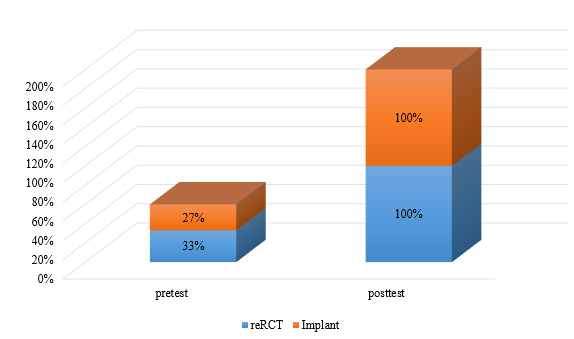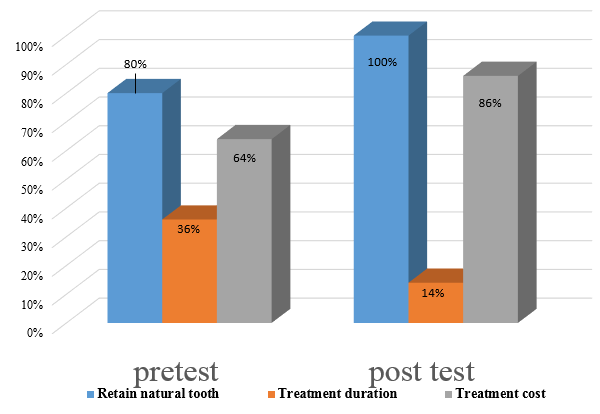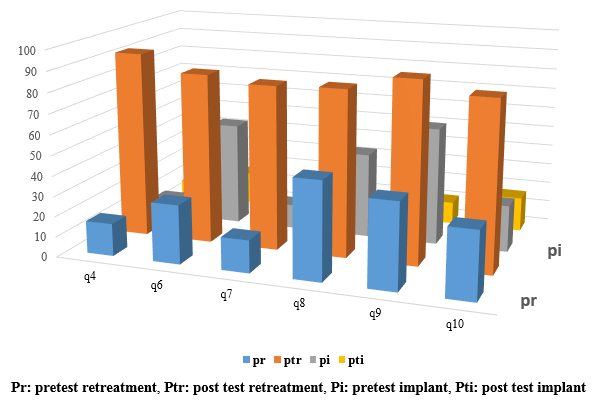- Visibility 195 Views
- Downloads 20 Downloads
- DOI 10.18231/j.ijce.2020.046
-
CrossMark
- Citation
Patients preference for endodontic retreatment or dental implant in failed endodontic treatment: A cross sectional study
- Author Details:
-
Benita M Fernandes *
-
Manjusha Warhadpande
-
Darshan Dakshindas
-
Jyoti Wankhade
-
Kuntal Wagh
Introduction
Tooth with pulpal and periapical disease can be successfully treated with root canal treatment. For patients with pulpal and periapical disease caused by caries or trauma, the main objectives of root canal treatment are to provide long term comfort, function, esthetics and prevention of reinfection. These objectives are achieved through complete cleaning and shaping, obturation of canals, and restoration of affected teeth.[1]
Endodontic treatment is fairly predictable in nature with reported success rates up to 86-98%.[2] However, there has not been a consensus in the literature upon a consistent definition of “success” criteria of endodontic treatment. Likewise “failure” has variable definitions. It has been defined in some studies as a recurrence of clinical symptoms along with the presence of periapical radiolucency.[3] The failure rate of endodontic treatment varies from 14- 57.9%.[4] An endodontically treated tooth should be evaluated clinically as well as radiographically for its root canal treatment to be deemed successful. A myriad of factors have been implicated in the failure of endodontic treatment. These include
Persistence of bacteria (intracanal and extracanal),
Inadequate filling of the canal (canals that are poorly cleaned and obturated)
Overextensions of root filling materials
Improper coronal seal (leakage)
Untreated canals (both major and accessory)
Iatrogenic procedural errors such as poor access cavity design
Complications of instrumentation (ledges, perforations or separated instruments) [5]
Treatment options after initial unsuccessful endodontic treatment include nonsurgical retreatment, endodontic surgery, tooth replantation, transplantation, extraction and replacement using single- tooth implant, extraction and replacement by using a fixed dental prosthesis, and extraction without replacement.[6], [7]
Patients with failed endodontic therapy, usually in conjunction with their dentist, make decisions regarding treatment from among more than one reasonable treatment option. Treatment options should be clearly and objectively communicated to the patient for them to make the best informed decision. Patient autonomy is desired as it allows for better patient cooperation and long term acceptance of the treatment modality.[8]
Limited literature (Foster et al, 2008) is available that demonstrates difference in the patients preference for non-surgical endodontic retreatment and extraction with implant placement in failed endodontic therapy when the information is provided to the patient.
This survey aimed to explore the patients preference for management of a tooth with failed endodontic treatment, when considering nonsurgical endodontic retreatment and extraction with implant placement as the two treatment options. This survey also set out to explore the influencing factors and effect of patient education about treatment in decision of making the treatment plan.
Material and Methods
This is a questionnaire based survey. The questionnaire was validated by 2 subject experts before commencing the survey. The survey protocol was reviewed and approved by the institutional Ethical committee. The study group was selected from among the patients visiting the OPD of Department of Conservative Dentistry & Endodontics for previously root canal treated teeth which were symptomatic. The teeth were clinically and radiographically analysed to confirm the diagnosis of failed endodontic therapy.
A total of 217 participants in the age range 20- 50 yrs, who had given their consent were considered in this cross-sectional study. Out of which 196 participants submitted and co-operated till completion of the survey. The survey tool was developed on the basis of previous literature and was validated. Survey tool (Appendix A) consist of two parts – Demographic data of participant and study related questionnaires.
Demographic data consist of participants name, age, sex, occupation and income. The pre-test and post test questionnaire were similar. Apart from demographic data, survey tool consists of 10 questions each. The questions analysed the participants preference to retain their natural tooth, awareness about the 2 treatment options, whether factors like cost, duration and success rate of the treatment option affected the choice of treatment, whether the preference of treatment would differ in anterior and posterior teeth and preference in teeth having iatrogenic complications with questionable prognosis.
After clinical and radiographic examination, participants were given pre-test forms to fill and filled forms were collected by one of the appointed observer. Then each participant was educated individually regarding treatment modalities in each case by using charts, models in layman terms by blind doctor. The post-test form were given to the same participant and again was collected by previous observer.
At the end of the survey both the pre-test and post-test questionnaire were statistically analysed using Chi square test. Level of significance was established at P < 0.05.
Results
The socio-demographic data showed that majority of the participants were females i.e. 58.4% as compared to males 41.6% and 84.8% of the participants received income from wages or self- employment. The results are presented in [Table 1]. Analysis of the pre-test and post-test questionnaire revealed that education and awareness session about the treatment options significantly influenced the choice of treatment option. ([Figure 1]) The pretest results showed that 16% preferred endodontic retreatment, 56% participants preferred extraction without replacement, 8% preferred dental implant, while 20% preferred only medication. However, the post-test results revealed that a majority of the participants preferred endodontic retreatment (92%) when compared to dental implant (8%); (chi square test, P < .001).
When asked about the factors that would influence the choice of their treatment option, the pretest results showed that 64% participants made treatment choice based on the cost of the treatment and 36% of the participants selected the treatment option based on the duration of the treatment modality. However in the post test results 86% of the participants considered the cost of the treatment while 14% suggested that the duration of the treatment would affect their preference for the treatment. (chi square test, P .002) ([Figure 2] )
However it was seen that when they were asked to decide between the treatment options irrespective of the factors like cost and duration of treatment plan it was noted that majority preferred endodontic re-treatment over dental implants. Significantly fewer participants preferred extraction with dental implant in both anterior teeth (16%) and posterior teeth (9%) in comparison to endodontic retreatment, 84% and 81% respectively; (chi square test, P <.001).
Regarding teeth with iatrogenic complications, the pretest results revealed that 54% participants preferred extraction. However in the post-test analysis 84% of the participants preferred endodontic retreatment while 17% preferred dental implant when the previously endodontically treated tooth had instrumentation complications like perforations and separated instrument. (chi square test, P <.001) ([Figure 3])
|
Q |
Result |
P value |
Significant |
|
|
|
Pre test |
Post test |
|
|
|
1 |
80% retain their teeth 20% extraction |
100% retain teeth |
0.01 |
Significant |
|
2 |
33% aware about re-RCT |
100% |
<0.001 |
Significant |
|
3 |
27% aware about Dental implant |
100% |
<0.001 |
Significant |
|
4 |
16% re-RCT 56% extraction 8% implant 20% only medication |
92% re RCT 8% implant |
<0.001 |
Significant |
|
5 |
64% treatment cost 36% duration of treatment |
86% cost 14% duration |
0.002 |
Significant |
|
6 |
For anterior teeth 29% re RCT 20% extraction 51% implant |
84% re RCT 16% Implant |
<0.001 |
Significant |
|
7 |
For posterior teeth 16% reRCT 72% Extraction 12% Implant |
81% reRCT 9% implant |
<0.001 |
Significant |
|
8 |
48% reRCT 42% Implant 8% none |
82% reRCT 8% Implant |
<0.001 |
Significant |
|
9 |
42% reRCT 58% Implant |
89% reRCT 11% Implant |
<0.001 |
Significant |
|
10 |
If perforations, separated instrument is peresnt 33% reRCT 54% Extraction 23% Implant |
83% reRCT 17% Implant |
<0.001 |
Significant |



Discussion
This survey aimed to elicit the preference of participants in selecting the treatment option for failed endodontic treatment when considering endodontic retreatment and dental implant as two viable treatment options. This survey also explored if the confounding factors or influences such as cost, duration of treatment procedure and long term prognosis of the treatment can affect the treatment preference. Also the level of the participants’ knowledge and awareness regarding endodontic retreatment and dental implant may influence their decision making and choice of the treatment modality.
The response rate of 90% (196/217) exceeded that of previous surveys of dental patients in Ontorio, Canada. [8], [9] This may be due to the direct personal interaction with the participants which was not the case in the previous surveys as the questionnaires were mailed to the participants.
Overall, the study participants reported a definitive preference for retaining teeth over extraction with dental implant. The results of the study showed that the awareness session describing the two reasonable treatment options for failed endodontic treatment can influence the option selected by the patient. This is in accordance to the study by Foster et al, (2008) in which 2 groups of patients received a biased information either about retreatment or extraction with dental implant. It was found that if treatment options are presented in a biased manner toward one option, the patient is more likely to select that particular treatment option. [10]
In this survey the participants were given two treatment options to analyse their preferences of one treatment over the other. The descriptions of the treatment options were kept short; qualitative description of the procedures included the number of appointments needed, time of completion, fare applicable, long term prognosis, need of surgical procedure for implant placement. The prognosis estimate of non-surgical endodontic retreatment and implant is 84.1%–88.6% and 98.3% respectively, and is a reasonable estimate to present both the treatment options to the patients for the treatment of their failed root canal therapy. [11]
Other treatment options for endodontically treated teeth with symptomatic PA lesions could include surgical retreatment, or a combination of nonsurgical and surgical retreatment and extraction with removable partial denture/ fixed partial denture. [12], [13] Surgical endodontic treatment could have been listed as an alternative third option with an approximate equivalent prognosis to nonsurgical retreatment or a better prognosis than nonsurgical retreatment. [14], [15], [16], [17] However, this survey wanted the participants to consider only 1 surgical option, that of extraction with implant placement.
Since cost estimates and treatment duration were included in the treatment description, the results of this study are skewed more towards the non-surgical endodontic retreatment. This could be probably because of the financial constraints of the study population and also the short duration of the treatment. As befits previous studies have concluded that dental implant is a high cost treatment plan. Moiseiwitsch et al (2007) evaluated the cost-benefit analysis of endodontics versus single-tooth implants. Their results indicated that the restored implant was 70%–400% more expensive than the restored endodontically treated tooth (crown). [18] In a study conducted by Pommer et al (2009) on the progress and mindset of patients about dental implants in Austria, the implant acceptance rate was found to be 56%, mainly because three quarter of the population considered the estimated cost of dental implant to be significantly high. [19]
However the results of this study showed that irrespective of duration and cost of treatment, extraction with dental implant was still preferred by a small percentage of the participants (8% and 11% respectively), may be because of the good long term prognosis of the treatment. Re-treatment of failed endodontic therapy is often complex. These procedures expose the patients to a significant decrease in the long term predictability of any planned restorations as valuable tooth structure is lost leading to decreased structural intergrity. Long-term implant survival rates better than 90% are well supported by the literature. [20]
It is also seen in the study, that when the endodontically treated tooth had complications like perforations and separated instruments initially in the pretest nearly 54% preferred extraction. This may be because of the fear or anxiety and lack of knowledge about the treatment options which are able to manage such complications. The previous data showed that dentally anxious individuals were more likely to be edentulous, and among the dentate, had more missing and fewer filled teeth. As a result, dentally anxious dentate subjects were more likely to need prosthodontic treatment. [21] However providing the dental patients with proper knowledge about the different treatment options plays a vital role in decision making and also reassures the patients confidence.
Limitations
This survey is institutional based and has included only the patients who have visited the institution. Opinion of the other general population was not considered.
Conclusion
Within the limitations of the study, the responses of the participants reflected a higher value for retention of teeth via endodontic retreatment over extraction with dental implant. The cost estimate and treatment duration were associated with higher preferences for tooth retention.
Since patients desire varying levels of autonomy when making decisions about their treatment plan, they will all rely to a certain extent on the information about the treatment options provided to them by their dentist. Therefore the patient’s dentist must objectively and ethically provide information to the patient regarding treatment options, treatment considerations, risks and benefits of the different options, and the expected prognosis of the different options.
Source of Funding
No financial support was received for the work within this manuscript.
Conflict of Interest
The authors declare they have no conflict of interest.
References
- M Torabinejad, S N White. Endodontic treatment options after unsuccessful initial root canal treatment. J Am Dent Assoc 2016. [Google Scholar]
- M Song, H C Kim, W Lee, E Kim. Analysis of the cause of failure in nonsurgical endodontic treatment by microscopic inspection during endodontic microsurgery. J Endod 2011. [Google Scholar]
- M Ashley, I Harris. The Assessment of the Endodontically Treated Tooth. Dent Update 2001. [Google Scholar]
- P M Di Fiore, L Tam, H T Thai, E Hittelman, R G Norman. Retention of Teeth Versus Extraction and Implant Placement: Treatment Preferences of Dental Faculty and Dental Students. J Dent Educ 2008. [Google Scholar]
- S Tabassum, F R Khan. Failure of endodontic treatment: The usual suspects. Eur J Dent 2016. [Google Scholar]
- M Torabinejad, P Anderson, J Bader, L J Brown, L H Chen, C J Goodacre. Outcomes of root canal treatment and restoration, implant-supported single crowns, fixed partial dentures, and extraction without replacement: A systematic review. J Prosth Dent 2007. [Google Scholar]
- S N White, M Torabinejad. From Tooth Retention Through Root Canal Treatment to Extraction and Replacement. Endod Prognosis 2017. [Google Scholar]
- A Azarpazhooh, T Dao, R Figueiredo, M Krahn, S Friedman. A Survey of Patients' Preferences for the Treatment of Teeth with Apical Periodontitis. J Endod 2013. [Google Scholar]
- A Koneru, M J Sigal. Access to dental care for persons with developmental disabilities in Ontario. J Can Dent Assoc 2009. [Google Scholar]
- K H Foster, E Harrison. Effect of presentation bias on selection of treatment option for failed endodontic therapy. Oral Surg, Oral Med, Oral Pathol, Oral Radiol, Endod 2008. [Google Scholar]
- A Chércoles-Ruiz, A Sánchez-Torres, C Gay-Escoda. Endodontics, Endodontic Retreatment, and Apical Surgery Versus Tooth Extraction and Implant Placement: A Systematic Review. J Endod 2017. [Google Scholar] [Crossref]
- H A G Balto, E M Al-Madi. A Comparison of Retreatment Decisions Among General Dental Practitioners and Endodontists. J Dent Educ 2004. [Google Scholar]
- T Pagonis, C Fong, G Hasselgren. Retreatment Decisions—A Comparison Between General Practitioners and Endodontic Postgraduates. J Endod 2000. [Google Scholar] [Crossref]
- T Kvist, C Reit. Results of endodontic retreatment: A randomized clinical study comparing surgical and nonsurgical procedures. J Endod 1999. [Google Scholar]
- M Farzaneh, S Abitbol, S Friedman. Treatment Outcome in Endodontics: The Toronto Study. Phases I and II: Orthograde Retreatment. J Endod 2004. [Google Scholar] [Crossref]
- N Wang, K Knight, T Dao, S Friedman. Treatment Outcome in Endodontics—The Toronto Study. Phases I and II: Apical Surgery. J Endod 2004. [Google Scholar]
- R Rubinstein, S Kim. Long-Term Follow-Up of Cases Considered Healed One Year After Apical Microsurgery. J Endod 2002. [Google Scholar]
- J Moiseiwitsch, D Caplan. A cost-benefit comparison between single tooth implant and endodontics. J Endod 2001. [Google Scholar]
- B Pommer, W Zechner, G Watzak, C Ulm, G Watzek, G Tepper. Progress and trends in patients' mindset on dental implants. II: implant acceptance, patient-perceived costs and patient satisfaction. Clin Oral Implants Re 2011. [Google Scholar]
- J D Ruskin, D Morton, B Karayazgan, J Amir. Failed Root Canals: The Case for Extraction and Immediate Implant Placement. J Oral Maxillofac Sur 2005. [Google Scholar] [Crossref]
- I Perković, M Perić, M R Knežević, S J Krmek. The Level of Anxiety and Pain Perception of Endodontic Patients. Acta Stomatol Croat 2014. [Google Scholar] [Crossref]
How to Cite This Article
Vancouver
Fernandes BM, Warhadpande M, Dakshindas D, Wankhade J, Wagh K. Patients preference for endodontic retreatment or dental implant in failed endodontic treatment: A cross sectional study [Internet]. IP Indian J Conserv Endod. 2020 [cited 2025 Sep 12];5(4):187-191. Available from: https://doi.org/10.18231/j.ijce.2020.046
APA
Fernandes, B. M., Warhadpande, M., Dakshindas, D., Wankhade, J., Wagh, K. (2020). Patients preference for endodontic retreatment or dental implant in failed endodontic treatment: A cross sectional study. IP Indian J Conserv Endod, 5(4), 187-191. https://doi.org/10.18231/j.ijce.2020.046
MLA
Fernandes, Benita M, Warhadpande, Manjusha, Dakshindas, Darshan, Wankhade, Jyoti, Wagh, Kuntal. "Patients preference for endodontic retreatment or dental implant in failed endodontic treatment: A cross sectional study." IP Indian J Conserv Endod, vol. 5, no. 4, 2020, pp. 187-191. https://doi.org/10.18231/j.ijce.2020.046
Chicago
Fernandes, B. M., Warhadpande, M., Dakshindas, D., Wankhade, J., Wagh, K.. "Patients preference for endodontic retreatment or dental implant in failed endodontic treatment: A cross sectional study." IP Indian J Conserv Endod 5, no. 4 (2020): 187-191. https://doi.org/10.18231/j.ijce.2020.046
